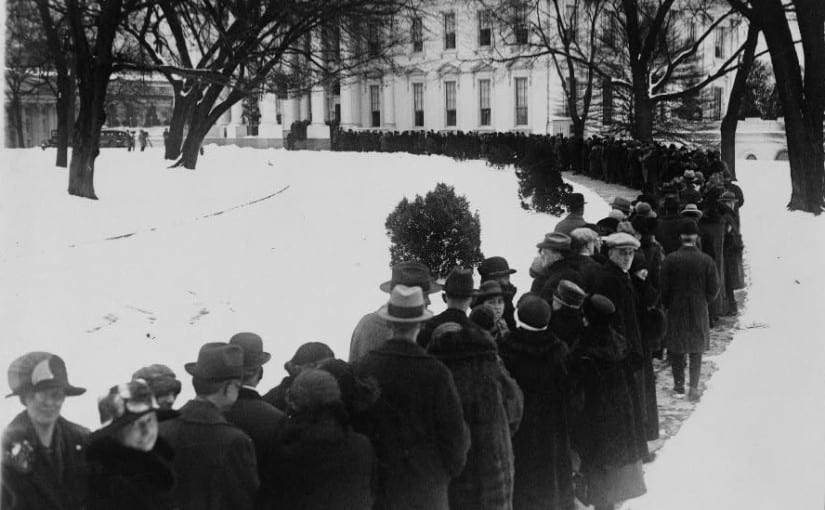With the annual turn of the civil calendar in the United States, temporal rituals in churches, public squares, civic spaces, and newspapers took shape that defined the nation as God-fearing, clock-oriented, and democratic. An array of practices associated with the turn of the calendar –such as rendering an account of the previous year, delivering and listening to sermons, and praying for mercy and deliverance,– emphasized the supremacy of a Christian God. As it unfolded year after year on January 1, New Year’s also became a particularly charged moment of what literary historian Thomas Allen calls “national time” in his book titled A Republic in Time. In Allen’s formulation, “national time” is a way in which “people imagine their collective life” that arises out of “the struggles of different individuals and groups to create a nation that reflects their interests and aspirations.” As much as Americans focused on their own personal life journeys with the arrival of the New Year, they also took interest in, and note of, the nation’s health and trajectory. To herald the arrival of the New Year, what we might call democratic temporal rituals took shape that drew attention to the nation’s preoccupations and in some cases its ideals.
Consider the annual New Year’s Day reception hosted by the President. The story begins at the end of the eighteenth-century in the parlor of George Washington’s Cherry Street mansion in New York City, where he received visitors wishing to pay the compliments of the season on New Year’s Day 1791. At the opening of the nineteenth century the party moved to the White House where subsequent Presidents received all-comers until 1932. Published accounts of the New Year’s Day reception circulated around and beyond the nation, as did photographs like the undated one above, showing a long line of people waiting to shake hands with either President Taft, Harding, or Coolidge. (Woodrow Wilson did not host New Year’s Day receptions). Reportage and editorializing about the reception consistently feature details about the character, comportment, and health of the President. For one day the reception provided a stage upon which it was possible to represent what equality might look like: after shaking the President’s hand, military officers, Native American entourages, politicians and their wives and daughters, foreign legations, and ordinary citizens mixed in the public rooms of the White House.
Accompanying this democratic temporal ritual was the rhetorical and at times real emphasis on freedom, self-determination, and new beginnings, which became evident on January 1, 1863 when after shaking hands for seven hours at the New Year’s Day reception, Abraham Lincoln signed the Emancipation Proclamation. Thereafter the day’s association with liberation, democracy, and freedom deepened. It did so in particular in New Year’s editorials, which often laid out high-minded programs that the nation ought to follow. As one African-American newspaper asked: “Will 1916 usher in a dawn of new freedom for the Negro Race? Will it bring the needed Emancipation from the shackles of color prejudice? Will the country say in the coming year, ‘Whatever an American citizen’s color may be,–white, black, or else—a man’s a man for all that?” The insistence on freedom and equality that the New Year’s annually drew attention to is exemplified by the same newspaper’s New Year’s greeting a few years later: “To the New Year, 1918, we bid a hearty welcome, hoping, and trusting that it has great things in store for our race, among which, we hope EQUALITY OF OPPORTUNITY AND EQUALITY OF PRIVILEGES [sic].” The New Year, next to the Fourth of July, was the preeminent moment when American dreams of equality and freedom were forcefully expressed in editorials, sermons, and private utterances. The utterance of these sentiments represents another democratic temporal ritual that characterized the arrival of the New Year in the United States.
A third democratic temporal ritual took place in the public sphere — in public spaces, radio broadcasts, and televised events–where the announcement of the moment of the New Year’s arrival generated a sense of collective belonging and hope. Even as New Year’s came to be in thrall of the clock, such that by start of the twentieth century, artificial illumination and precision chronometry together had pushed New Year’s observances from the day of January 1 into the night before, it continued to be a democratic temporal ritual. Some of the rituals associated with the stroke of midnight prodded Americans to imagine the nation and their place within it. For instance, when radio listeners heard “church bells and chimes scattered across the continent ring out the old year and welcome 1926 on New Year’s Eve,” as one newspaper reported, they came to apprehend anew the expanse of the nation, and yet to feel a sense of connection to far-flung places where bells rang in the New Year. Nearly half a century later, in 1973, when Dick Clark began hosting the live show “Rockin’ New Year’s Eve” from New York City’s Times Square, the drop of the ball at midnight underscored the distance of American viewers, and eventually foreign ones too, from New York City. But the televised scene also connected viewers to New York, to Times Square, and to the crowds who joyously celebrated the ball’s drop.
You may email me at <amccross@smu.edu> for permission to quote or borrow from this post. Otherwise please do not quote or borrow. Thanks.
